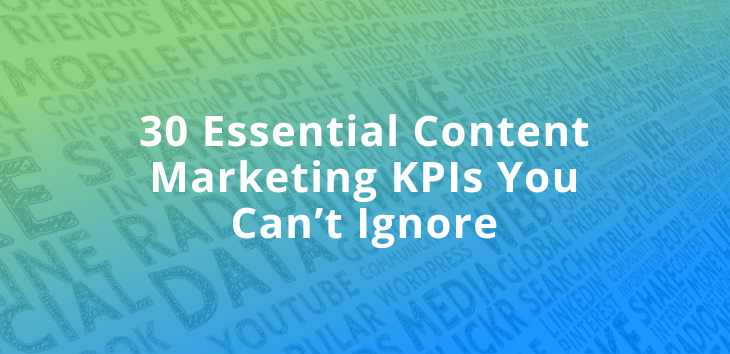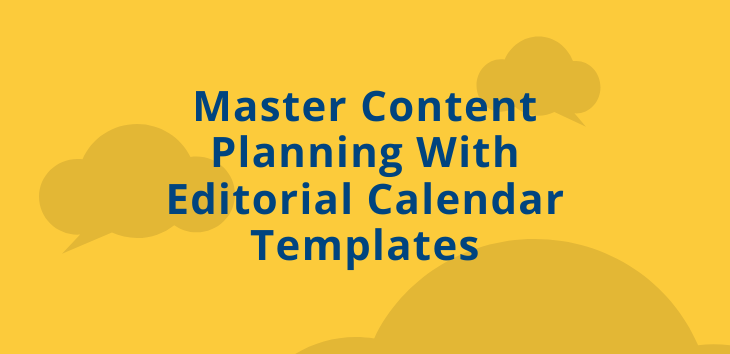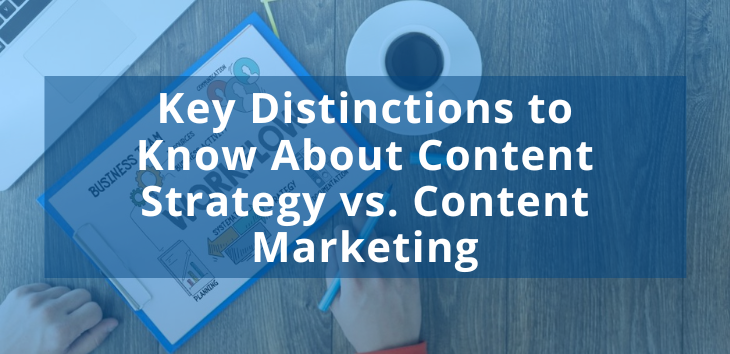Head-turning content marketing campaigns that get people excited about brands don’t simply happen. They result from thorough planning, an in-depth understanding of the target audience, and an airtight strategy for monitoring continuous progress. Tracking the right content marketing KPIs is a crucial part of that equation.
But what exactly are content marketing KPIs, and what do you use to measure content success when you’re serious about staying competitive? Here, we’ll discuss some of the most critical content marketing KPIs to keep in mind as you map out your next strategy.
What Is a KPI in Content Marketing?
KPI, or “key performance indicator,” refers to quantifiable values that content marketers use to assess the health and progress of a long-term strategy or a particular campaign. Engagement, audience reach, and conversion rate are a few examples that can help a marketer better measure progress toward a specific objective.
Data is the key to tracking the success of any endeavor. It offers clear evidence of whether your goals have been met, surpassed, or not reached. Analyzing data can also help savvy marketers identify golden opportunities for cost savings, brand expansion, or engagement with new demographic groups.
Today’s content marketing landscape is ever-changing, and successful marketers evolve accordingly. Proactively leveraging your data and tracking carefully selected content marketing KPIs keeps you ahead of the curve in all the right ways. The following examples are 30 critical content marketing KPI examples to watch moving forward.
Website Content Marketing KPIs
A website’s ability to attract and engage visitors is critical to the success of your content marketing efforts. Here are some essential KPIs for measuring content success related to website performance.
1. Impressions
If impressions are lower than expected, try tweaking your keyword strategy or reassessing your targeting goals to ensure you’re going after the right demographics. In the case of paid advertising, consider whether it might be worthwhile to kick your budget up a notch.
Impressions count the total number of times content is displayed to unique users on various platforms.
It’s also important to note that as search engines evolve, the number one search result on Google isn’t necessarily the most desirable SERP position anymore. Features like knowledge panels and featured snippets are much more visible, and SEO strategies are evolving to include them. However, such features often fulfill user queries directly on the search page, potentially reducing traffic to websites.
2. Website traffic
When it comes to primary digital marketing analytics, website traffic is one of the first KPIs that most marketers think of, and with good reason. Website traffic numbers help you better understand your site’s overall reach and user interaction.
Gain additional insights into this metric by delving into individual traffic sources to learn more about how people find your sites. Reinvest in successful entry points (social media, Google ads, etc.) and content types. Analyze the paths visitors follow as they explore your site for additional insights into user behavior.
3. SEO rankings
Visibility is important; even the most well-written content won’t help a brand if no one can find it. Keeping tabs on your SEO rankings allows you to measure the effectiveness of your ongoing efforts.
Ensure your rankings keep moving in the right direction by making keyword research an ongoing part of your approach, taking care to include plenty of trending terms. Focus on building your backlink catalog, crafting uniquely useful content, and updating your high-performing content articles to keep them relevant.
4. Time spent on page
Attracting visitors to your content is only part of the battle when it comes to winning the content marketing game. You also need to hold their attention once you’ve got it, and tracking content marketing metrics like time spent on a page can help you determine how well you’re doing this.
Longer page dwell times generally correlate to higher engagement rates, so explore different ways to drive those numbers up. Add graphics and videos to lend visual interest. Ensure content is readable and easy to consume by organizing it well, using clear headings, and a narrative flow that guides readers smoothly from section to section.
5. Repeat visitor ratio
How do new visitors behave once they’ve discovered your content? Is that the last you see of them, or do they keep returning for more? Your repeat visitor ratio clues you into how well you’re cultivating user loyalty and fostering ongoing interest in what you’re doing content-wise.
Content marketers can improve this metric by giving audiences more of what they want, personalizing the user experience, updating popular content, and consistently publishing new articles. Additionally, promote engagement through social media and email subscriptions so your audiences never miss a content drop.
6. Lead generation
While content marketing is certainly about delivering standalone value to audiences, it’s important to remember it’s also about turning curious consumers into paying customers. Content manager KPIs like lead generation help lend valuable insight into this process.
Before you can begin nurturing leads, you need to generate qualified ones via ethical but effective tactics. Examples to consider include:
- Using powerful calls-to-action (CTAs).
- Implementing gated content to capture data.
- Offering incentives like freemium content to encourage visitors to opt into mailing lists or follow on social media.
7. Quality of leads
Beyond quantity, quality of leads is also important, especially for brands in the SaaS sector and other highly specific niches. However, all brands can benefit from targeting consumers who are not only likely to convert but also ready to.
Personalized content is key, as relevance is essential for capturing and retaining user interest. So can targeting individuals across all stages of a typical buyer’s journey. Utilize tools like buyer personas to help your content production team better target and personalize key content efforts.
8. Voice search optimization success
With the rising popularity of voice-operated options like Alexa and Google Assistant, voice search optimization is ever more important. Keep track of metrics that help assess how voice search-friendly your content is.
Make your content easier to discover via voice search by using long-tail keywords and conversational tone that reflects natural speech patterns. Leverage schema markup to structure your data to help search engines understand it better. If your business is location-specific, pay attention to local SEO, as well.
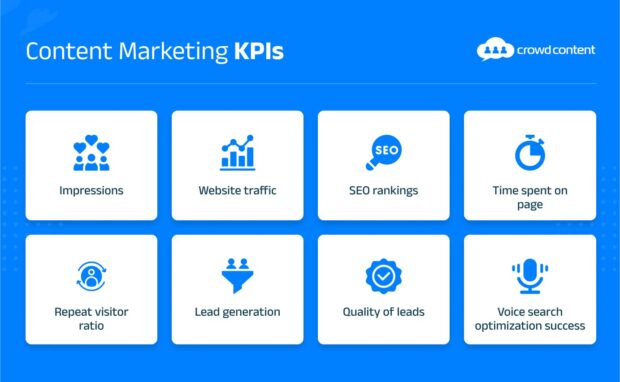
Content-Focused Marketing KPIs
Naturally, your content (both written and visual) is the heartbeat of any digital marketing strategy, so KPIs related to its structure and performance are crucial concerns. Here are a few content performance metrics to watch closely.
9. Content production speed
Quality may be king in content production, but consistency is queen. Content marketing success in 2024 calls for more than just informative, high-quality content. Marketers aiming to keep their brands top of mind must also generate content regularly, making content production speed an important KPI to know.
Developing a comprehensive content calendar that includes everything from updates to your company blog to your social media channels and newsletter can help you stay ahead of content production. Consider repurposing existing content and delegating creation tasks to expert writers and creators to streamline the process.
10. Content accessibility score
Inclusion and accessibility are the orders of the day in 2024, including when it comes to content marketing. Tracking your content accessibility score helps ensure your output adheres to all current quality standards and is as helpful as possible to all users, including those with disabilities.
You can keep your content accessibility score high by making your content as easy to consume as possible. Use large fonts that are easy to read, pay attention to strong contrast between text and background colors, and use headings to lend structure and readability to written content. Look into additional options like video captions, text transcripts, and accessible visual elements.
11. Content innovation index
In a digital landscape where every brand competes online with eye-catching content, genuine uniqueness is priceless. The more innovative and original your content is, the better it will perform in capturing the attention of your target audience.
You can boost your content innovation index by developing a deep understanding of your target audience and their needs. Pay attention to what’s already working for you, and use what you know to strike a solid balance between familiar and novel moving forward. Also, be sure to add your unique voice to your content – your most distinct asset that cannot be replicated by others.
12. Content update frequency
While producing plenty of fresh, original content is crucial, you don’t want to leave your existing content out in the cold when it comes to your ongoing strategy. Updating existing web content frequently – especially any that consistently draws traffic your way – keeps it visible to search engines and relevant for your audience.
To optimize this KPI, plan for quarterly updates for topics that change often. Annual updates are sufficient for key evergreen topics that are more stable.Integrate content updates into your ongoing content calendar to keep efforts consistent and timely.
13. User-generated content volume
Saying user-generated content (UGC) is a game-changer for brands in 2024 is a real understatement. UGC boosts engagement rates, drives interest in key products or services, and builds trust through compelling social proof. For that reason, tracking UGC volume can lend marketers powerful insight into how well they’re engaging their audience.
Encourage more UGC by actively requesting your to share their experiences or give feedback. Hold contests, giveaways, and similar events to incentivize incredible UGC, and be sure to engage with those who follow through by commenting and sharing.
14. Multimedia content engagement
Successful content marketing involves more than just written content like blogs, ebooks, and social media status updates. Today’s audiences crave and seek out variety in their content, and different demographics may have specific preferences to keep in mind.
Include multiple forms of media in your own content strategy – for example, videos, infographics, interactive graphics, etc. – alongside your standard written content. Add multimedia content engagement to your running list of trackable content marketing KPIs to gauge which content formats are most popular with your audience. Pay special attention to universally popular options like short-form videos as they tend to attract broad interest.
15. Content sentiment analysis
As important as facts and information are when it comes to getting a consumer to finalize a purchase decision, emotions are a lot more powerful. Create content that makes people feel things, and you’re well on your way to crafting an established, popular brand. Tracking content marketing KPIs like content sentiment ensures you stay aligned with these goals.
Sentiment analysis evaluates your content by comparing the frequency of positive versus negative expressions. Mood-associated words that invoke feelings of confidence, encouragement, professionalism, etc., also factor into the mix. Utilize AI tools – like Grammarly, to name just one – to help in this analysis. Apply what you learn to fine-tune the emotional appeal of your content and invoke desired responses.
16. Content experimentation rate
Constant experimentation and innovation are crucial to maintain a vibrant and successful content marketing strategy. But it’s equally important to track the success of all your attempts, so you know what’s working and what’s not. Monitoring content experimentation rate and related content marketing KPIs can help you here.
A/B testing is a proven method for comparing two or more versions of a campaign or content approach. Monitor specific metrics like test velocity, quality, win rate, and percentage uplift to gain additional insights into what’s really working and why.
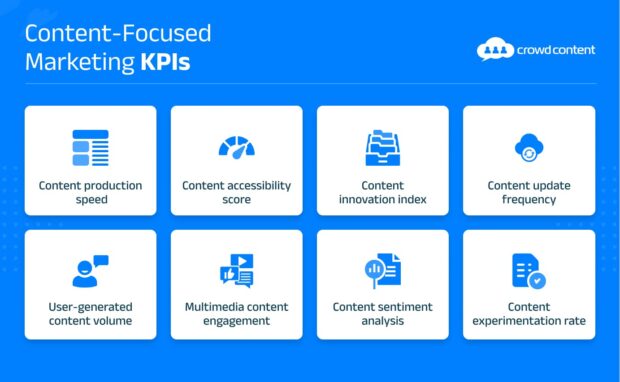
Branding and Marketing-Focused Content Marketing KPIs
Effective KPI tracking in marketing means staying on top of metrics that reveal how you’re doing with your branding efforts, content performance, and overall return on your marketing investment. Here are some KPIs to help you do that.
17. Return on investment (ROI)
At the end of the day, content marketing is a business investment, so tracking the ROI of content marketing efforts is imperative. ROI is expressed as a percentage that compares the gains from your investment against the initial costs. To calculate ROI, use the formula: (return – investment ÷ investment) x 100 = ROI.
However, ROI also has a qualitative aspect. In addition to the financial numbers, consider factors like lead generation, customer loyalty rates, and overall brand awareness when determining ROI.
18. Brand awareness lift
In a nutshell, brand awareness speaks to how likely consumers are to instinctively recognize your brand or any of its products, services, slogans, or visual assets. The better your brand awareness, the more likely people are to actually choose your brand in competitive markets.
And what do you measure in content marketing when you want to gauge your ongoing brand awareness lift rate? Be on the lookout for metrics like share of voice, referral traffic, branded search volume, and earned media coverage. Enhance visibility by creating relevant content, distributing it across multiple channels, and supporting it with consistent promotion efforts.
19. Share of voice
Don’t underestimate the importance of share of voice (SOV) when assessing potentially useful content marketing KPIs. SOV measures how well your audience is vibing with your brand overall and how well it’s doing compared to your competition. You can leverage SOV to help you analyze social media performance, PPC advertising strategy, organic traffic, etc.
Ensure a healthy share of voice metrics by researching your audience and staying on top of their evolving needs and expectations. Develop shareable content to match and infuse it with your unique brand voice. Collaborating with influencers, thought leaders, and other brands can also help with SOV.
20. Content cost vs. performance
Just as it’s important to keep track of your overall content marketing ROI, you’ll also want to track your content cost vs. performance to ensure your efforts are as productive as possible. Useful metrics to consider include views, engagement rate, user behavior, number of new users, traffic numbers, etc.
Maximize your content’s efficiency by fully optimizing and repurposing it across multiple platforms in ways that make sense for your brand. Form strategic partnerships to expand your reach and help your content find new audiences. Invest in content types and approaches that resonate well with your audience.
21. Influencer collaboration effectiveness
Influencer marketing can be a powerful way to expand your reach for several reasons. Influencers come attached to highly engaged audiences who take recommendations to heart. Partnering with the right candidates in your niche can really take your brand awareness to the next level. However, keeping track of metrics related to influencer collaboration effectiveness is important.
Specify clear goals for your collaborations, communicate them to your partners, and track KPIs that align accordingly. Analyze ongoing collaborations and make adjustments as needed to optimize results. Learning from past campaigns can strengthen future efforts.
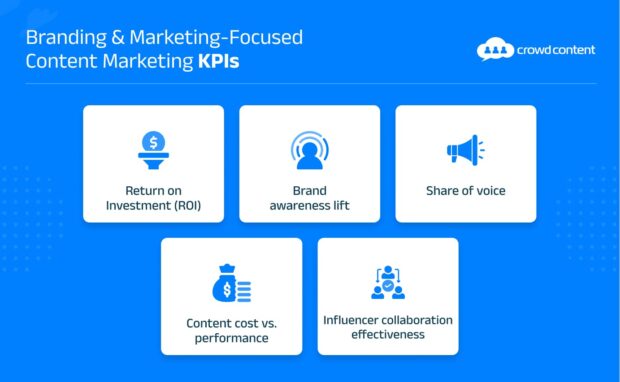
Audience and Customer Content Marketing KPIs
No comprehensive list of the best KPIs for content marketing would be complete without metrics that help you fully gauge how your content is landing with existing and potential customers. Here are some examples of essentials to keep in mind.
22. Engagement rate
Tracking engagement rates is a key part of gauging the overall success of your content. People engage with content that resonates with them. They comment on it, share it on their social media feeds, and reference it when producing their own content. Algorithms take note of all those little interactions and show engaging content to even more people.
To elevate engagement, consider incorporating calls for audience interaction or developing dynamic, interactive content. Such types of content not only captivates but also improves memory retention and overall brand recall due to its immersive nature.
23. Conversion rate
In content marketing, your conversion rate (CVR) reflects the overall percentage of web visitors who successfully complete a desired action. That action could be to finalize a sale, but it could also be to download freemium content, sign up for a mailing list, follow on social media, etc.
Higher conversion rates imply effective content that successfully educates, persuades, and leads audiences to act. You can fortify your content conversion rates by improving your overall user experience, crafting compelling calls to action, and highlighting key value propositions in your copy. Implement A/B testing to refine your messaging and improve content strategies across different formats.
24. Email open rates
If you’re like most people, you’re on multiple branded mailing lists but don’t necessarily have time to open every email you receive. Chances are you open the ones that seem most relevant to you or otherwise pique your curiosity and forego the rest. Your customers are the same.
The likelihood of an email being opened increases with its relevance and personalization. Segment your recipient lists according to criteria like past behavior, demographics, or location, and personalize email blasts accordingly. Craft irresistible subject lines, and be sure to send messages at optimal times to boost the chances of engagement.
25. Social shares
In a digital world where almost everyone has a social media presence and spends time on their favorite platforms daily, your social share metric is one of the most critical content marketing KPIs to monitor. People share content that resonates with them and that they’re proud to endorse to their friends and followers.
Determine where your target audience spends their social media time and build a strong, active presence on those platforms. Tailor your content for maximum shareability on each platform, incorporating visuals, strong headlines, and social sharing buttons into website content to boost your content’s shareability.
26. Customer retention rate
Well-crafted content is more than an effective way to attract new potential customers in your direction. When used wisely and approached skillfully, it can encourage loyalty and repeat business.
After defining your goals, do a deep dive into your audience’s pool of interest. Serve up content that meets their needs as repeat customers and brand-loyal consumers. You could include options that help clients get more out of existing purchases or take better care of the products they already own. Serialized content can also be effective in making sure your customers are engaged over time.
27. Audience growth rate
Tracking and analyzing your audience’s growth rate can give you valuable marketing insight into how well your overall content strategy is going. Examining details like traffic sources and comparing the strength of your presence on different platforms can tell you a thing or two about your current market reach.
You can supercharge your audience growth rate metric by prioritizing innovation in your content approach. Focus on informing, entertaining, and genuinely delighting your customers with your content offerings. Form partnerships with influencers and other thought leaders in your niche to expand your reach even further.
28. Customer satisfaction score (CSAT) post-content interaction
Monitoring how satisfied your customers are after interacting with your branded content is a solid way to assess how well your content offerings meet their needs. Content that is interacted with, shared, or endorsed typically meets or exceeds expectations.
Examining engagement KPIs (like conversion rate, churn rate, retention rate, and bounce rate) helps you get a more detailed read on how you’re doing here.
Customer feedback loops also lend valuable insight. Pay attention to what customers say in their comments and share captions. (Social listening interfaces may help catch everything.) Utilize feedback via polls, surveys, and social media posts to enhance your content strategies
29. Net Promoter Score (NPS) related to content
Net Promoter Score (NPS) is a simple but informative metric that measures overall customer satisfaction, loyalty, and enthusiasm about a brand. To obtain one, you ask customers one simple question: “On a scale of 1 to 10, how likely are you to recommend us to a friend?”
A high NPS often correlates with customers who enjoy their experience enough to recommend it to others. Apply NPS to gain insight into how your customers feel about your content. Focus your content strategy on delivering helpful, entertaining content throughout every stage of the customer life cycle to maintain high NPS levels.
30. Content reach by geographic location
Understanding where your customers are from can help you more effectively tailor content to their needs. Examine your content and traffic metrics to assess where your reach is the strongest. Are most of your customers local or global? Are there specific cities or regions where your reach is particularly strong?
Explore unique behaviors, preferences, and purchasing patterns of these areas to create tailored content. Ensure you’re paying enough attention to local SEO related to those locations to enhance your reach further.
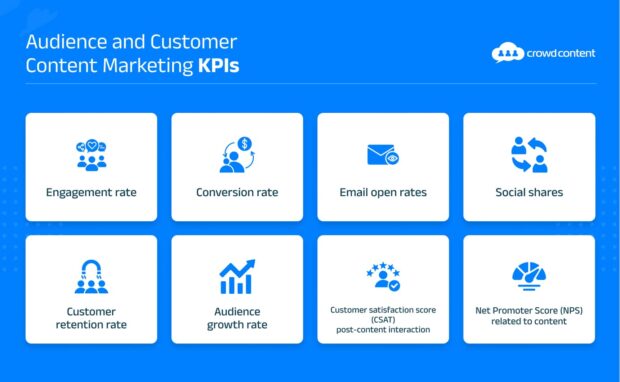
Elevating Your Content Strategy with KPIs
Although commonly tracked KPIs like web traffic, customer engagement, and customer retention rate should always make your list of go-to content marketing KPIs, they’re not all there is to the picture. Monitoring and analyzing a well-rounded list that includes gems like the examples listed above gives you a much fuller understanding of how you’re really doing and helps you stay competitive in an increasingly crowded digital space.
Ready to take your content marketing game to the next level? Let the seasoned content experts at Crowd Content help you revolutionize your strategy and fully leverage key content marketing KPIs to maximize your brand success. Get in touch today, and tell us more about your content goals.
